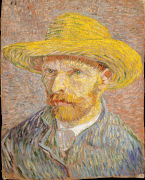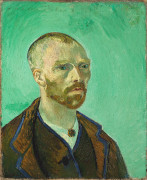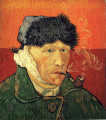Project "The Interpretation of Painting by Binary"

What made Van Gogh cut off his Ear.
Artist: Kenji Kojima, 2023
|
Show: Japanese / 日本語
Hide: Japanese / 日本語
このプロジェクトは、1887 年から 1889 年までのヴィンセント・ヴァン・ゴッホの自画像の視覚データをバイナリー解析によって、12 音階の音楽として解釈する 5 つの短いビデオにまとめたものです。 ヴィンセント・ヴァン・ゴッホは、キャンバスに何度も自画像を描きました。 ビデオの最初の3枚の絵は、彼の耳がまだあった時に描かれ、残りの2枚は耳を切り落とした後に描かれました。 人類の歴史のすべてのメディアは現在、縮小され、バイナリ (0,1) としてデジタル データに記録されています。 バイナリは、コンピューターが実行する最低レベルのマシン コードです。バイナリはアートマテリアルに用いると、メディア間のクロス感性を可能にします。この作品では視覚を聴覚に変換しています。 新型コロナウイルス感染拡大後、アーティストの小島健治は、作品のビデオ撮影のための外出を自粛していました。彼はパブリック ドメインの古典絵画のデジタル画像をネットで入手できることを思い出しました。急速に発展するデジタルの世界で、アナログ美術の歴史を振り返る良い機会です。バイナリは物質としては空です。おそらく私たちは物理的なアート素材を扱う最後の世代になるかもしれません。しかし私たちはまだ、実空間における手触りの創作を知っています。 アーティストの小島は、視覚と聴覚のそれぞれの情報が重なり合うと考えてきました。外の世界から受ける印象は、あなたの心の中で音楽になります。音楽をキャンバスに表現して絵画が生まれます。このプロジェクトは、絵画から音楽を掘り起こす発掘調査です。彼はコンピュータ アルゴリズムが人間の感性を再現できるかどうかについて、実験的なアート・アプリケーションを開発しました。カリフォルニア大学での最近の研究によると、私たちの脳はバラバラに変化する視覚情報をタイムライン上にまとめることで、環境に対する安定した認識を作り出すと言っています。小島がプログラムしたアルゴリズムは、タイムライン上の色のバラバなグリッド データを 2 進数でランダムに収集し、音符に変換して MIDI ピアノを演奏しました。 Hide: Japanese / 日本語 This project compiled 5 short videos that interpret the visual data of Vincent van Gogh's self-portraits from 1887 to 1889 as 12-tone music through binary analysis. The total length is 15:30. Vincent van Gogh painted self-portraits many times on his canvases. The first three paintings of the video were painted when he still had his ear, and the other two were painted after he cut off his ear. All media in human history are now reduced and recorded in digital data as binary (0,1). The binary is the lowest level of machine code for the computer to execute. Art material binary creates media cross sensibilities possible. After COVID-19, the artist Kenji Kojima was refraining from going out to shoot a video for his artwork. He recalled he could get digital images of public domain classic paintings on the net. It was a good chance to reflect on analog art history in the rapidly developed digital world. The binary is physically empty. Probably we are the last generation of handling physical art materials. We have known the tactile sense of the hand in actual space. Artist Kenji Kojima has been thinking seeing and hearing overlap with each information of the senses. This project is the excavation that digs music from paintings. He developed the experimental art application on whether computer algorithms can reproduce human sensibility. A recent study at the University of California that our brain creates a stable perception of the environment by putting together disjointed changing visual information on a timeline. The algorithm he programmed collected disjointed grid data of colors on a timeline randomly by binary and converted them to musical notes and played midi piano. Show: Kenji Kojima's Biography
Hide: Kenji Kojima's Biography
Kenji Kojima is a digital artist. He has been experimenting with the relationships between perception and cognition, technology, music, and visual art since the early 1990s. Primarily he has interested in the relationship between seeing and hearing. He was born in Japan and moved to New York in 1980. He painted egg tempera paintings that were medieval art materials and techniques for the first 10 years in New York City. His paintings were collected by Citibank, Hess Oil, and others. The personal computer improved rapidly during the 1980s. He felt more comfortable with computer art than paintings. He switched His artwork to digital in the early 1990s. His early digital works were archived in the New Museum - Rhizome, New York. He developed the computer software "RGB MusicLab" in 2007 and created an interdisciplinary work exploring the relationship between images and music. He programmed the software “Luce” for the “Techno Synesthesia” project in 2014. His digital art series was exhibited in New York, at media art festivals worldwide, including Europe, Brazil, and Asia, and the online exhibitions by ACM SIGGRAPH and FILE, etc. Anti-nuclear artwork “Composition FUKUSHIMA 2011” was collected in CTF Collective Trauma Film Collections / ArtvideoKoeln in 2015. He started the new series "The Musical Interpretation of Paintings and Photographs" which creates music from image data in 2021. LiveCode programmer. https://kenjikojima.com/ Hide: Kenji Kojima's Biography |
 0:20
0:20 02:46
02:46 05:32
05:32 08:09
08:09 11:49
11:49